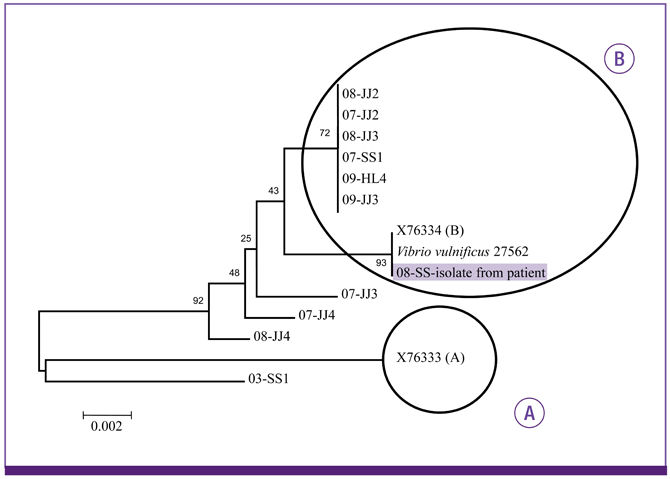Infect Chemother.
2014 Jun;46(2):106-109. 10.3947/ic.2014.46.2.106.
Isolation of Vibrio vulnificus from Seawater and Emerging Vibrio vulnificus Septicemia on Jeju Island
- Affiliations
-
- 1Department of Microbiology and Immunology, Jeju National University School of Medicine, Jeju, Korea.
- 2Department of Internal Medicine, Jeju National University School of Medicine, Jeju, Korea. neosangtaek@naver.com
- 3Department of Laboratory Medicine, Jeju National University School of Medicine, Jeju, Korea.
- 4Department of Earth and Marine Science, Jeju National University College of Ocean Science, Jeju, Korea.
- KMID: 2284987
- DOI: http://doi.org/10.3947/ic.2014.46.2.106
Abstract
- Vibrio vulnificus is an opportunistic human pathogen, transmitted from seawater, raw oyster, and shellfish and responsible for severe septicemia. We studied V. vulnificus from surface seawater around Jeju Island between 2010 and 2011. In 2010, V. vulnificus was isolated and V. vulnificus septicemia was reported. Surface seawater temperature is an important factor for growth of V. vulnificus, and here we showed that high surface seawater temperature may influence growth of V. vulnificus and occurrence of emerging V. vulnificus septicemia on Jeju Island. This is the first report of isolation of V. vulnificus and emerging V. vulnificus septicemia on Jeju Island.
Keyword
Figure
Reference
-
1. Wittman RJ, Flick GJ. Microbial contamination of shellfish: prevalence, risk to human health, and control strategies. Annu Rev Public Health. 1995; 16:123–140.
Article2. Tuyet DT, Thiem VD, Von Seidlein L, Chowdhury A, Park E, Canh DG, Chien BT, Van Tung T, Naficy A, Rao MR, Ali M, Lee H, Sy TH, Nichibuchi M, Clemens J, Trach DD. Clinical, epidemiological, and socioeconomic analysis of an outbreak of Vibrio parahaemolyticus in Khanh Hoa Province, Vietnam. J Infect Dis. 2002; 186:1615–1620.
Article3. McLaughlin JB, DePaola A, Bopp CA, Martinek KA, Napolilli NP, Allison CG, Murray SL, Thompson EC, Bird MM, Middaugh JP. Outbreak of Vibrio parahaemolyticus gastroenteritis associated with Alaskan oysters. N Engl J Med. 2005; 353:1463–1470.
Article4. Kim HJ, Kwak HK, Lee J, Yun YJ, Lee JS, Lee MS, Min SY, Park SK, Kang HS, Maeng YH, Kim SY, Kim SY, Kook YH, Kim YR, Lee KH. Patterns of pncA mutations in drug-resistant Mycobacterium tuberculosis isolated from patients in South Korea. Int J Tuberc Lung Dis. 2012; 16:98–103.
Article5. Nilsson WB, Paranjype RN, DePaola A, Strom MS. Sequence polymorphism of the 16S rRNA gene of Vibrio vulnificus is a possible indicator of strain virulence. J Clin Microbiol. 2003; 41:442–446.
Article6. Thompson JD, Gibson TJ, Plewniak F, Jeanmougin F, Higgins DG. The CLUSTAL_X windows interface: flexible strategies for multiple sequence alignment aided by quality analysis tools. Nucleic Acids Res. 1997; 25:4876–4882.
Article7. Saitou N, Nei M. The neighbor-joining method: a new method for reconstructing phylogenetic trees. Mol Biol Evol. 1987; 4:406–425.8. Kaspar CW, Tamplin ML. Effects of temperature and salinity on the survival of Vibrio vulnificus in seawater and shellfish. Appl Environ Microbiol. 1993; 59:2425–2429.
Article9. Kelly MT. Effect of temperature and salinity on Vibrio (Beneckea) vulnificus occurrence in a Gulf Coast environment. Appl Environ Microbiol. 1982; 44:820–824.
Article10. Colwell RR. Global climate and infectious disease: the cholera paradigm. Science. 1996; 274:2025–2031.
Article
- Full Text Links
- Actions
-
Cited
- CITED
-
- Close
- Share
- Similar articles
-
- Generalized Erythema Multiforme-like Eruption is the Novel Cutaneous Manifestation of Vibrio Vulnificus Septicemia
- Epidemiology and clinical characteristics of vibrio vulnificus septicemia in Pusan and Kyungnam area
- Effect of Hydrogen Ion Concentration on the Growth of Vibrio vulnificus
- Vibrio vulnificus infection: a persistent threat to public health
- Cultural Characteristics of Vibrio vulnificus on Various Media



